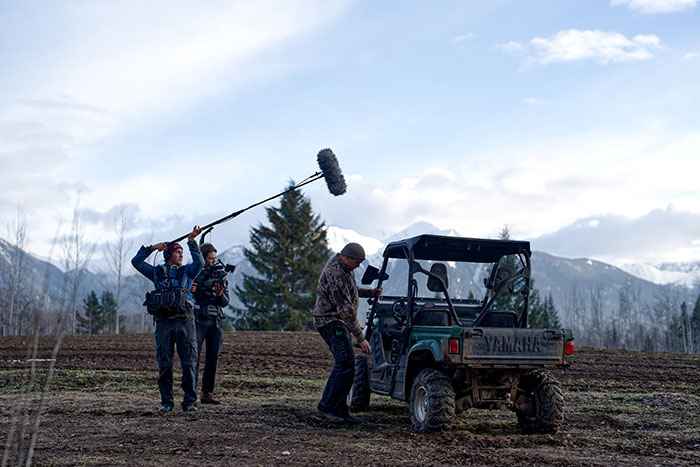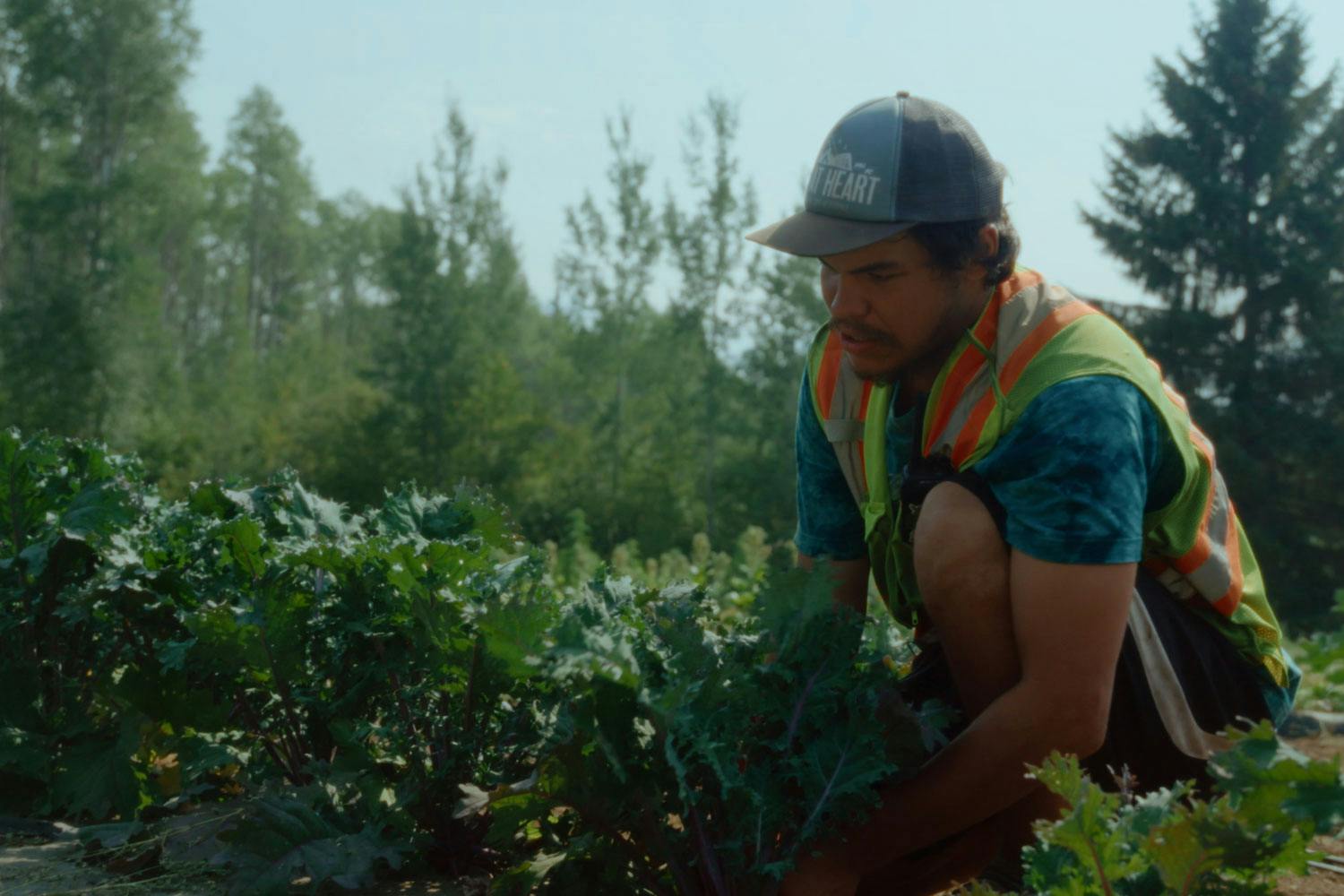This BC Farm Grows Indigenous Food Sovereignty
The documentary Tea Creek spotlights the successes and challenges of a small farm with big ambitions.
Justice Moore harvests kale in a film still from Tea Creek.
When Justice Moore says “I wouldn’t be here if Tea Creek weren’t here,” you can tell he means it.
Tea Creek—a family farm turned award-winning Indigenous food sovereignty training centre—is the subject of a new eponymous documentary directed by Ryan Dickie. Tea Creek the film is having its world premiere at this year’s DOXA Documentary Film Festival.
Moore started out as one of many trainees spending a growing season at Tea Creek Farm, and is now a landscape horticulture apprentice there. The farm is in Gitxsan territory, colonially known as northwestern British Columbia. Jacob Beaton co-owns the farm with his partner Jessica Ouellette and says in the film that as Tea Creek grew, they found themselves unexpectedly leading a movement for Indigenous food sovereignty.
The land they’re on is particularly fitting for what Tea Creek has blossomed into. Beaton explains that he was told by a hereditary chief that the valley has long been “what we’d now call farm and ranch land.” But colonization disrupted Indigenous food systems, and has largely erased Indigenous agricultural history with them. According to Beaton—who has Haida, Heiltsuk, Tsimshian, and British ancestry—Canadian society largely brushes over the fact that Indigenous peoples intentionally stewarded their lands for agricultural use. Beaton says the myth that Indigenous societies depended only on hunting and gathering is so pervasive because it makes it easier to justify the theft of their lands.
Against this historical backdrop—and the intergenerational trauma, food insecurity, and climate change it has wrought—the film follows Beaton through Tea Creek’s successes and financial challenges. Highlighting human stories like Moore’s within this context was the shared vision of director Dickie (who has Dene and Kwakwaka’wakw ancestry) and producer Ben Cox.
“There are so many stories like Justice’s at Tea Creek,” Cox told me over the phone. The filmmakers knew they wanted to focus on a junior farmer to help tell the story, but at the beginning of production, they didn’t know who that would be. “It turned out that person was Justice—and Justice is incredible.”
Moore—who is Gitxsan and Tsimshian from Gitwangak village (also known as Kitwanga) south of Tea Creek—says in the film that he’s benefitted from the consistent support at the farm. “You’re always appreciated, you’re always valued, you’re always respected.” Explaining that he was in a “dark place” before getting involved with Tea Creek, Moore credits his new environment with keeping him sober and making him more confident.
The farming activities of Tea Creek are in lockstep with its service as a healing space for Indigenous community members.
Running Tea Creek has been a transformative experience for Beaton, too. “I’ve always struggled with my identity as an Indigenous person, being white as well,” he says in the film. He sought out therapy to disrupt “the multigenerational mechanism” of trauma that was passed down from his grandfather—a residential school survivor—and affected Beaton’s life as a young man.
“In the last few years, with Tea Creek, I’ve definitely become more comfortable,” he says, “because I have a heart-to-heart connection with so many of our participants and staff.”
Many of the participants depicted throughout the film echo similar sentiments of healing and transformation. The farming activities of Tea Creek are in lockstep with its service as a healing space for Indigenous community members.
Beaton says the “Tea Creek Model” is “a natural evolution of being a good community member.” This includes simple, neighbourly acts like picking up people who don’t have a ride to the farm and feeding someone if they’re hungry. In the documentary, Beaton expresses surprise at how rare this kind of approach was among other trades training programs.
Tea Creek’s multifaceted approach to community resilience—including social, environmental, and economic elements—is what makes it special. Beaton says median incomes for Indigenous people in the valley where Tea Creek sits range “between $13,000 and $20,000 a year,” which makes it hard for families to maintain food security with limited resources. Beaton calls the farm’s style of agriculture “Indigenous-inspired modern agricultural food production, where you can easily feed your family in your front yard or backyard with very basic tools.”

The Tea Creek film crew shoots footage of Jacob Beaton on the farm.
Local food production like Tea Creek’s has environmental benefits and helps build food-system resilience. Beaton points out in the film that more than half of the produce consumed in Canada is imported. The risk of system breakdown—which could be induced by anything from a pandemic to climate disasters—is high when we rely so heavily on our current fragile systems.
But despite the important niche Tea Creek fills, finding funding has been a consistent challenge. For Beaton, this precarity descends directly from the food-system destruction that Canadian public policy wrought on Indigenous nations. He says action to repair that damage is missing from official efforts at reconciliation. Producer Cox says he believes that, for Beaton, “public policy created this problem, and therefore, public policy and government should fund Tea Creek.”
Tea Creek’s precarity descends directly from the food-system destruction that Canadian public policy wrought on Indigenous nations.
A cycle of excitement, opportunity, and dashed hopes have plagued Beaton’s efforts. In one scene, Beaton shares an update after a call with a company initially interested in providing funding: “It’s just… there’s no money.”
“It was heartbreaking to see their ups and downs,” Cox told me. “We followed them for two, three years, and the funding problem that we captured in the final scene… that happened like every second week.”
The costs of running the program are high for Beaton, but the costs of not running it are higher. In one dramatic scene, he explains that over the winter—when funding ran out and the farm was forced to shut down—the farm lost four community members who had relied on Tea Creek as a healing space. “People die because Tea Creek isn’t operating,” Beaton says.
Tea Creek staff have asked Beaton to emphasize this during fundraising efforts to communicate how essential Tea Creek is to the wider Indigenous community. Viewers of the film can feel the urgent need for the support Tea Creek provides, but it remains to be seen whether funders will feel that pull, too.
At the beginning of Tea Creek, Indigenous food sovereignty is defined as “the right for Indigenous people to produce, distribute, and consume their own food.” By the end, however, it’s clear that it’s also a radical embrace of hope and a commitment to healing in the face of traumatic history.
Tea Creek (73 min) screens May 4 at 4:15 pm (at The VIFF Centre) and May 9 at 8:45 pm (at the SFU Cinema). Tickets are available on the DOXA website.
